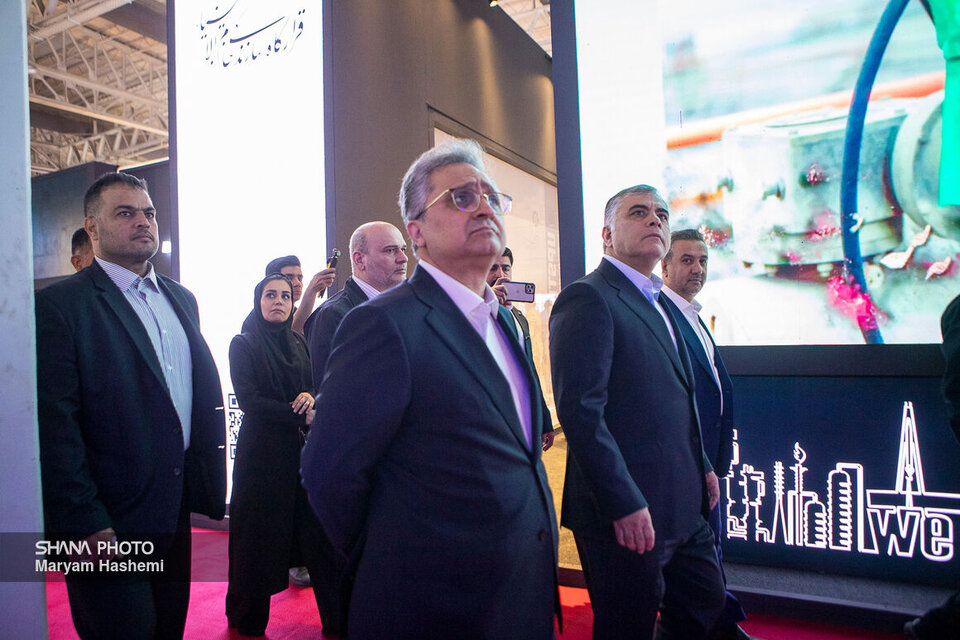Dressed in his signature crisp suit, Paknejad stepped into the heart of the oil industry not as a mere guest but as a concerned father looking to guide and advise his children.
He started in Halls 8 and 9, asking technical and challenging questions that left booth managers wide-eyed. Journalists, weighed down by heavy bags, cameras on their shoulders, and microphones in hand, lined up like soldiers. Each tried to break free from the crowd, hoping to ask a question, capture a reaction, or extract even a single word from the minister.
Hall 5 was even livelier. There, the National Iranian Gas Company had assembled all its subsidiaries in an orderly display, logos raised like battle flags, awaiting the minister’s arrival. A company representative rushed forward, his panting breaths mixing with the clicks of cameras and shouts of photographers telling him to move aside. “Just five minutes,” he pleaded. “Let me explain.” The minister stood firm, listening despite the protests of his security detail.
What made this visit different was not just the act of touring but the way he moved, stood, and listened. Paknejad wasn’t there to hide or sugarcoat anything—he was there to see. It was as if he had stepped into the trenches of the oil industry.
Pressure boosting and contracting challenges at Khatam al-Anbiya Construction Headquarters’ booth
At the Khatam al-Anbiya Construction Headquarters booth, discussions centered on infrastructure development, engineering, and pressure-boosting projects in South Pars. Officials spoke about platform construction, transportation, future plans, and the private sector’s role.
Paknejad inquired about progress and challenges. Booth representatives emphasized ongoing preparations for new platforms at Bushehr’s Sadra Yard.
One of the minister’s key concerns was the contracting process and genuine private-sector involvement. “You know this is a top priority,” he said. “Private sector participation not only speeds up processes but also boosts the economy.”
However, bureaucratic hurdles remain a major obstacle. Contractors hope for faster approvals, and officials announced an upcoming meeting with the National Iranian Oil Company to expedite South Pars pressure-boosting contracts.
The visit underscored efforts to accelerate major projects like South Pars—a goal requiring government, contractors, and private-sector collaboration.
OICO’s booth: Launching precision engineering, optimal scheduling
At OICO’s booth, executives outlined progress in developing oil and gas fields, including Mordan. With the contract nearly ready for signing, Paknejad advised, “Opportunities remain. Your company must now define its path, assess options, and take strategic steps.”
Petropars: Projects on schedule
At Petropars, Paknejad stressed adherence to timelines and reviewed developments in fields like Sefid Baghoun and Sefid Zakher. Officials confirmed the readiness of development plans, submitted months earlier, and noted Parsian Holding’s investment readiness. The Fajr Jam refinery has spare capacity, which could be utilized if production increases.
The minister suggested leveraging steel companies’ investments, given their energy needs.
NIGC: Managing energy infrastructure
Officials showcased advanced technologies, including real-time monitoring of 40,000 km of pipelines. Geographic information systems (GIS) and AI-driven crisis management tools help swiftly locate incidents and deploy solutions.
Domestic suppliers now meet most equipment needs, though challenges like Turbo Compressor-25 persist. Paknejad praised the workforce for maintaining gas network stability, noting repairs are completed within 14 hours of disruptions.
Major projects, including the Sarajeh storage facility, Ilam refinery, and the Ahvaz-Kouhdasht gas pipeline (boosting daily extraction by 20 million cubic meters), are underway. Innovations like AI and VR training enhance technical skills, with new hires learning in virtual refineries.
A visit that became a social movement
What stood out was the exhibitors’ eagerness—everyone wanted the minister at their booth, to take photos, to share concerns. To them, he wasn’t just an official but a beacon of hope.
He had come not to sit behind a desk but to listen. Not just to speak but to know. Not to perform but to act. What was meant to be a formal visit turned into something far more: a social movement. Without claiming miracles, Paknejad sought solutions—from the booths, from experience, from those who’d lived and breathed oil.
He had come to learn. To listen. And, if possible, to make a difference.


Your Comment